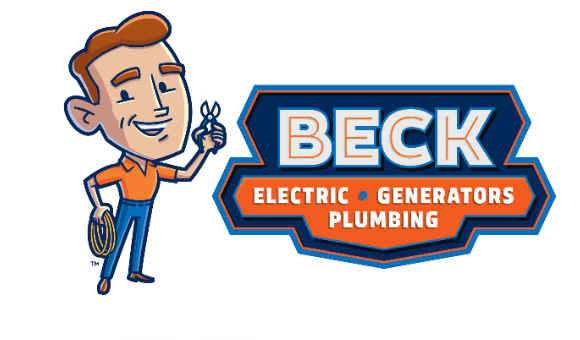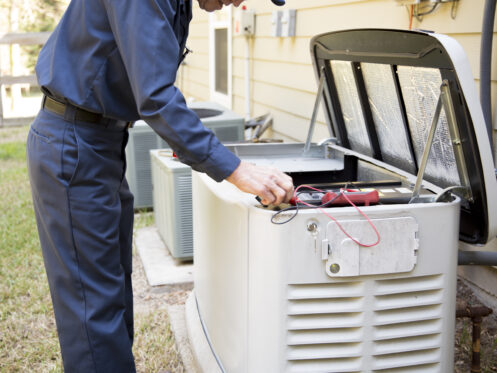Extreme weather conditions have been on the rise in northeastern Ohio, and access to a whole-house generator can be invaluable after an unexpected power outage. Whether you’re up against increased utility failure during an intense storm season or simply want to secure an uninterrupted power supply, installing a whole-house generator is an excellent choice.
Determining the right-sized whole-house generator is among the primary challenges you’ll face in identifying the appropriate backup power solution. This article will walk you through the necessary steps for choosing a correctly sized backup power solution to run your home electronics after a blackout.
Reviewing Your Household’s Power Requirements
To select the right-sized generator, you’ll need to assess your household’s power requirements. Start by determining how much electricity you’ll need to run all your electric appliances and devices after the lights go out.
Fortunately, calculating your total wattage isn’t complicated. All you have to do is take a complete inventory of your appliances and electronically powered systems and list their typical wattage requirements.
If, for example, you own a refrigerator that runs on 700 watts but requires up to 1200 watts, you should make note of both figures. Likewise, if your air conditioner runs on 3,500 watts but requires 4500 watts to start, document both figures and save them for your final calculations.
You’ll have to differentiate between running and starting watts because some devices draw significantly more power when you turn them on. This is called surge power. Disregarding your surge watt requirements will only increase your chances of selecting a generator that doesn’t meet your household power demands.
Every home has unique critical and non-critical loads. Critical loads are those you cannot live without during an outrage. This power requirement refers to household items like refrigerators, heating and cooling systems, and essential lighting.
Non-critical loads could be home conveniences like toaster ovens, dishwashers, television sets, and gaming devices. All of these things are nice to have around but are unnecessary for basic living. Ultimately, you’ll have to decide which devices are essential and which are not. However, recognizing the importance of this distinction will help you choose the most suitable product for your residence.
Exploring the Different Whole-House Generator Types
When evaluating the best backup power solution for your home, there are three primary whole-house generators to consider. This list includes standby generators, portable generators, and inverter generators.
Each solution comes with its own advantages and disadvantages. To understand what whole-house generator will work best for your property, you’ll need to familiarize yourself with their key differences. Now, let’s take a detailed look at how these three generator types work below.
Standby Generators
Backup power sources permanently installed in your home are known as standby generators. This type of generator automatically activates the moment it detects a power outage. The backup power system is hardwired to your home and typically relies on natural gas or propane for fuel.
Standby whole-house generators are typically more reliable and convenient than other options because they fully integrate into your home. The solution lets you transition quickly during a blackout, instantly giving you an uninterrupted power source. Furthermore, standby generators can power critical and non-critical loads at most properties.
The only real drawback to standby generators is their high cost. They can be expensive to purchase and install, especially if you are retrofitting a new unit to an existing home. These backup power systems also require regular maintenance, another budget consideration.
Inverter Generators
Inverter generators are more advanced renditions of the classic portable generator. They rely on complex electronic circuitry to deliver clean power that is safe to use with your sensitive home electronics like computers and mobile devices.
These generators offer quiet operation and are more fuel-efficient than your typical consumer-grade portable solution. The main upside to an inverted generator is that it provides stable, clean power sufficient to serve as a reliable source for your home and outdoor activities.
Since they’re not as expensive as standby generators, inverter generators offer an attractive middle ground between a fully integrated backup solution and the less effective portable models you find at your local home improvement store.
If you opt for an inverted generator, just remember they don’t support the same wattage as the more costly standby generators. As such, this backup power solution will be more limited for whole-house applications.
Portable Generators
If you’re searching for affordable backup power that you can move around, portable generators are always a reliable option. This solution runs gasoline, diesel, or propane and can, depending on the model, deliver surprising amounts of power. The primary benefit of using a portable generator is its low cost and flexibility.
You can use portable generators for more than just a home backup. For instance, you can operate them at campsites or run photography lights and equipment in the field. They will, however, require manual setup during an outage.
Of course, this extra step is one of the downsides of a portable generator. It can be inconvenient and time-consuming to set up during an emergency. While portable generators are the least expensive option, they also generate considerably less power than the alternative solutions above.
Sizing a Whole-House Generator
After you’ve made a comprehensive list of appliances and systems along with their load requirements, you’re ready to start sourcing a backup power solution. Remember to include both running and surge watts in your calculation and identify all the essential items you’ll need to power during an outage.
Before researching specific generator products, calculate your total running watts and the highest starting watts from your list. Even if your figures aren’t entirely accurate, this number should give a reliable point of departure for your required backup power.
Next, start looking at the capacity range of prospective generators. Whole-house generators come in a wide range of capacities, from 5000 to 20,000 watts or more. For the typical residential property, a generator in the 10,000 to 15,000-watt range should be enough to power your critical and non-critical loads.
If you plan on adding to your home or purchasing more appliances, remember to choose a slightly more powerful generator to account for these future changes in demand. Lastly, you should always consult with a professional. An experienced electrician can offer expert guidance and supply you with the most accurate information, including details on the latest solutions, to help you make an informed decision.
Ensuring Continuous Power With a Whole-House Generator
Selecting an appropriately sized whole-house generator will make all the difference during your next power outage. After just a few basic calculations, finding the right unit with ample power shouldn’t be too complicated. Many backup power solutions require professional installation assistance, however. At Beck Electric, Generators & Plumbing, our knowledgeable electricians can equip you with an ideal-sized generator and provide a high-quality installation service in Canton, OH. We also offer a full range of plumbing and electrical solutions.
For more on selecting a premium whole-house generator that meets all your home’s backup power requirements, contact us at Beck Electric, Generators & Plumbing today!






